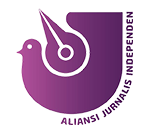AI Integration in Broadcast Production Management at Radio XChannel
Abstract
The use of Artificial Intelligence (AI) in Indonesia has experienced rapid growth. As of early 2025, Indonesian users recorded over 300 million visits to AI applications, placing the country among the top ten globally in AI usage. Worldwide, 87% of organizations had adopted AI in at least one operational function, including within the radio broadcasting sector. Radio XChannel is one of the Indonesian radio stations that began integrating AI into its operations. This study aimed to explore the station’s AI adoption strategy and identify the opportunities and challenges faced during implementation. A qualitative method with a descriptive approach was employed. Data were collected through in-depth interviews and documentation of broadcast materials and internal policies related to AI. This study examines how AI is applied in XChannel, based on radio production management processes, and how AI can provide a different perspective. The research findings indicate that XChannel is starting to implement AI to adapt to digital disruption while also addressing the need for efficiency to meet the challenges of the radio business. However, the application of AI remains limited to text-to-audio conversion, playing the role of a news anchor in news segments. Meanwhile, AI is not yet utilized in the live broadcast process and is only employed in content production for the YouTube channel. These findings suggest that the use of AI in the radio industry, specifically at XChannel, is still in its early stages and faces both technical challenges and human resource constraints. Further research is recommended to explore more comprehensive AI integration strategies and evaluate their impact on audience engagement and the quality of the produced content.
Keywords
Full Text:
PDFReferences
Abdurrahman, M., Dulwahab Sufyan, E., Salma, A. N., & Parsono, S. (2025). From broadcasters to herbal sellers: The commercial-ethical shift in indonesian local radio. Journal of Radio & Audio Media, 1–14. https://doi.org/10.1080/19376529.2025.2502764
Ajisafe, I. O., & Dada, D. (2023). Radio broadcasting in the digital age: Adapting to the challenges of the 21 st century. International Journal of Advanced Mass Communication and Journalism, 4(1), 36–44. http://masscomjournal.com/archives/2023.v4.i2.A.69
Arwan, A., Syarifah, S., & Darmawati, D. (2024). Analisis penggunaan media radio republik indonesia sebagai siaran pendidikan di Pekanbaru dan Kuantan Singingi. Jurnal Educatio: Jurnal Pendidikan Indonesia, 10(2), 286–295. https://doi.org/10.29210/1202425243
Ashfaq, R., Nabi, Z., & Rohit. (2023). Artificial intelligence and the Indian media industry: The future is now. The Journal of Media, Culture and Communication, 3(1), 14–21. https://doi.org/10.55529/jmcc.31.14.21
Asim, D. S. A. S. (2024). A significance of artificial intelligence in overall development of human in the digital era. International Journal For Multidisciplinary Research, 6(2), 1–5. https://doi.org/10.36948/ijfmr.2024.v06i02.15596
Besman, A., & Evita, N. (2024). AI in semi-automated journalism: A review of Indonesia’s journalistic ethics. Jurnal Studi Komunikasi, 8(3), 583–594. https://doi.org/10.25139/jsk.v8i3.7978
Daruhadi, G., & Sopiati, P. (2024). Research data collection. International Journal of Social Service and Research, 4(7). https://doi.org/10.46799/ijssr.v4i7.863
Dwivedi, Y. K., Ismagilova, E., Hughes, D. L., Carlson, J., Filieri, R., Jacobson, J., Jain, V., Karjaluoto, H., Kefi, H., Krishen, A. S., Kumar, V., Rahman, M., Raman, R., Rauschnabel, P. A., Rowley, J., Salo, J., Tran, G. A., & Wang, Y. (2021). Setting the future of digital and social media marketing research: Perspectives and research propositions. International Journal of Information Management, 59, 102168. https://doi.org/10.1016/j.ijinfomgt.2020.102168
Fieiras-Ceide, C., Vaz-Álvarez, M., & Túñez-López, M. (2022). Artificial intelligence strategies in European public broadcasters: Uses, forecasts and future challenges. Profesional de La Información, 31(5). https://doi.org/10.3145/epi.2022.sep.18
Furtáková, L. (2023). Dokáže chatgpt nahradiť moderátora spravodajstva v rozhlase?// can chatgpt replace a radio news anchor? In Quo vadis . UCM FMK. https://www.researchgate.net/publication/371761230
Hafied, H., Irwanto, I., Surjatmodjo, D., & Latuheru, R. (2025). AI-driven media evolution: exploring automated journalism’s impact on industry’s future. Kajian Jurnalisme, 8(2), 205–218. https://doi.org/10.24198/jkj.v8i2.53801
Harliantara, H., Sompie, D. J., & Sutika, I. M. (2024). Radio broadcasting with artificial intelligence: A case study on Radio Mustang Jakarta. Communicatus: Jurnal Ilmu Komunikasi, 8(1), 121–138. https://doi.org/10.15575/cjik.v8i1.34403
Havidz, H. B. H., & Suprapto, E. (2021). The role and function of management in global organizations. Dinasti International Journal of Digital Business Management, 2(4), 744–753. https://doi.org/10.31933/dijdbm.v2i4.1201
Hayati, K., & Ariestanty, C. (2023). Konstruksi pendengar radio pada masyarakat Indonesia (studi kasus pada aplikasi Noice). Global Komunikas: Jurnal Ilmu Sosial Dan Ilmu Politik, 6(1). https://doi.org/10.33822/gk.v6i1.5756
Herjanto, E. (2004). Manajemen produksi dan operasi (2nd ed.). Grasindo.
Hu, M., Xiang, Z., & Li, K. (2021). Application of artificial intelligence voice technology in radio and television media. Journal of Physics: Conference Series, 2031. https://doi.org/10.1088/1742-6596/2031/1/012051
Ibrahim, R. (2024). Manajemen penyiaran Radio Arrisalah dalam meningkatkan minat pendengar pada era new media. Al-Fiqh: Journal of Islamic Studies, 2(2), 80–88. https://doi.org/10.59996/al-fiqh.v2i2.525
Isdayani, B., Thamrin, A. N., & Milani, A. (2024). Implementasi etika penggunaan kecerdasan buatan (AI) dalam sistem pendidikan dan analisis pembelajaran di Indonesia. Digital Transformation Technology, 4(1), 714–723. https://doi.org/10.47709/digitech.v4i1.4512
Ismiati, N. (2000). Slogan dan tagline senjata pamungkas iklan. Gramedia Pustaka Utama.
Jia, Z. (2022). Analysis methods for the planning and dissemination mode of radio and television assisted by artificial intelligence technology. Mathematical Problems in Engineering, 1. https://doi.org/10.1155/2022/7538692
Kustiawan, W., Nabila, S. T. P. G., Sembiring, N. B., Salam, A. A., Lubis, S. Z., Nandini, N., & Sayrevi, M. Z. (2023). Radio broadcasting basic. Jurnal Pendidikan Tambusai, 7(2). https://doi.org/10.31004/jptam.v7i2.6933
Kuyucu, M. (Michael). (2020). Artificial intelligence in media: Radio automation systems as the first artificial intelligence application in media in the terms of “threats” and “opportunities.” Digital Transformation and Innovation 4th International New Media Conference (25-26 April 2019, Istanbul, Turkey), 133–168.
Listiyoningsih, R., Pawito, P., & Rahmanto, A. N. (2025). Exploration of media ethics in the AI Era: A case analysis of Radarsolo.com. Kajian Jurnalisme, 8(2), 189–204. https://doi.org/10.24198/jkj.v8i2.59388
Miles, M. B., Huberman, A. M., & Saldana, J. (2014). Qualitative data analysis: A methods sourcebook (3rd ed.). SAGE Publications.
Morissan. (2011). Manajemen media penyiaran: Strategi mengelola radio dan televisi. Kencana.
Mulyani, H. S., Kusmayadi, I. M., & Basith, A. A. (2022). TikTok sebagai media kampanye pengelolaan sampah masker di masa pandemi bagi generasi Z. JE (Journal of Empowerment), 3(1), 103–114. https://doi.org/10.35194/je.v3i1.2389
Phillips, M. J. (2023). Towards a social constructionist, criticalist, Foucauldian-informed qualitative research approach: Opportunities and challenges. SN Social Sciences, 3, 175. https://doi.org/10.1007/s43545-023-00774-9
Rostamian, S., & Kamreh, M. M. (2024). AI in broadcast media management: Opportunities and challenges. AI and Tech in Behavioral and Social Sciences, 2(3), 21–28. https://doi.org/10.61838/kman.aitech.2.3.3
Shilina, M. G., Volkova, I. I., Bombin, A. Y., & Smirnova, A. A. (2023). Artificial journalism: The reverse of human-machine communication paradigm. Mapping the field of AI critical media studies. RUDN Journal of Studies in Literature and Journalism, 28(4), 757–768. https://doi.org/10.22363/2312-9220-2023-28-4-757-768
Sjuchro, D. W., Al-Faqih, M. Z., Sumadiria, A. H., Zubair, F., Gemiharto, I., Syuderajat, F., Basith, A. A., & Kusnandar. (2025). Etika dan regulasi media. Simbiosa Rekatama Media.
Sonni, A. F., Hafied, H., Irwanto, I., & Latuheru, R. (2024). Digital newsroom transformation: a systematic review of the impact of artificial intelligence on journalistic practices, news narratives, and ethical challenges. Journalism and Media, 5(4), 1554–1570. https://doi.org/10.3390/journalmedia5040097
Toptaş, S. (2024). Geleneksel radyodan yapay zekâ radyo yayıncılığına; 2. dalga podcastler ve alternatif yayıncılık. Akdeniz Üniversitesi İletişim Fakültesi Dergisi, 46, 133–152. https://doi.org/10.31123/akil.1537647
Wei, M., Scifo, S., & Xu, Y. (2022). Artificial intelligence and radio broadcasting opportunities and challenges in the Chinese context. In The Routledge Companion to Radio and Podcast Studies (1st ed.). Routledge.
DOI: https://doi.org/10.24198/jkj.v9i1.63631
Refbacks
- There are currently no refbacks.
Copyright (c) 2025 The Author(s)

This work is licensed under a Creative Commons Attribution-NonCommercial-ShareAlike 4.0 International License.
Kajian Jurnalisme Indexed by:
Editorial Office of Kajian Jurnalisme:
Journalism Study Program, Faculty of Communication Sciences, Universitas Padjadjaran
Building 3 2nd Floor, Jl. Raya Bandung Sumedang KM.21, Jatinangor, Sumedang Regency, West Java 45363
Email: kajian.jurnalisme.fikom@unpad.ac.id
Telepon: (022) 7796954
Faks: (022) 7794122
Kajian Jurnalisme Supervised by:













